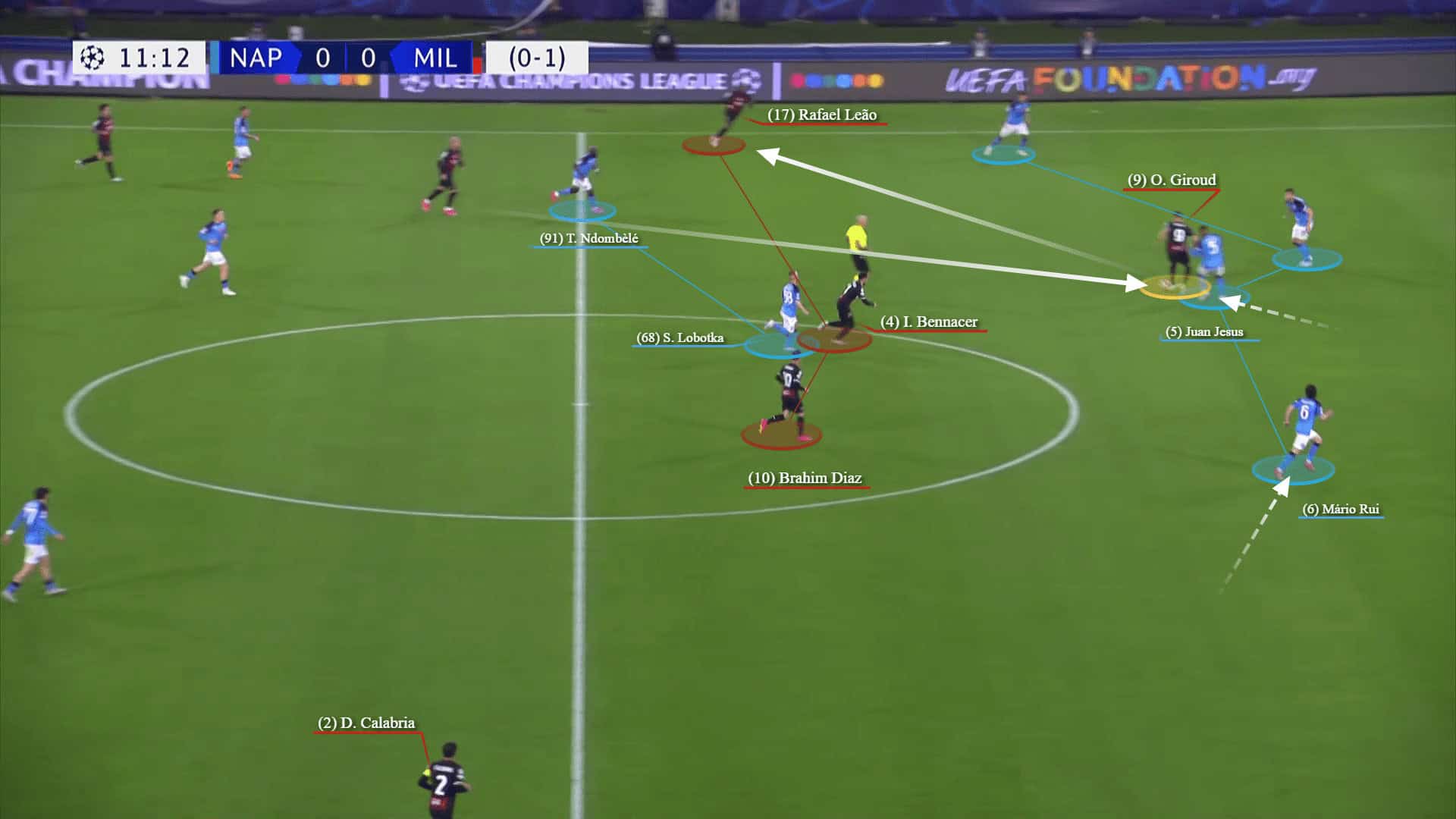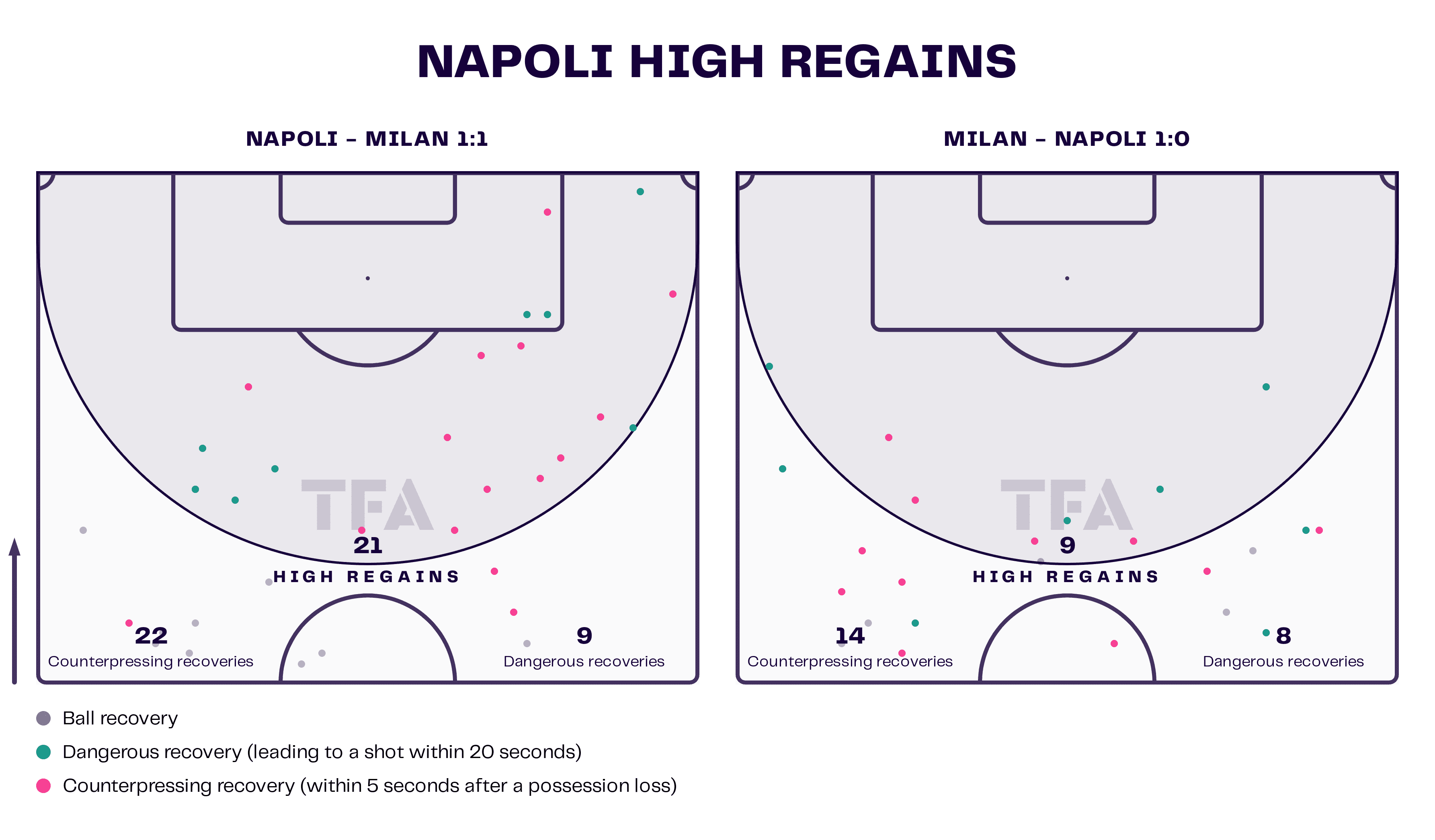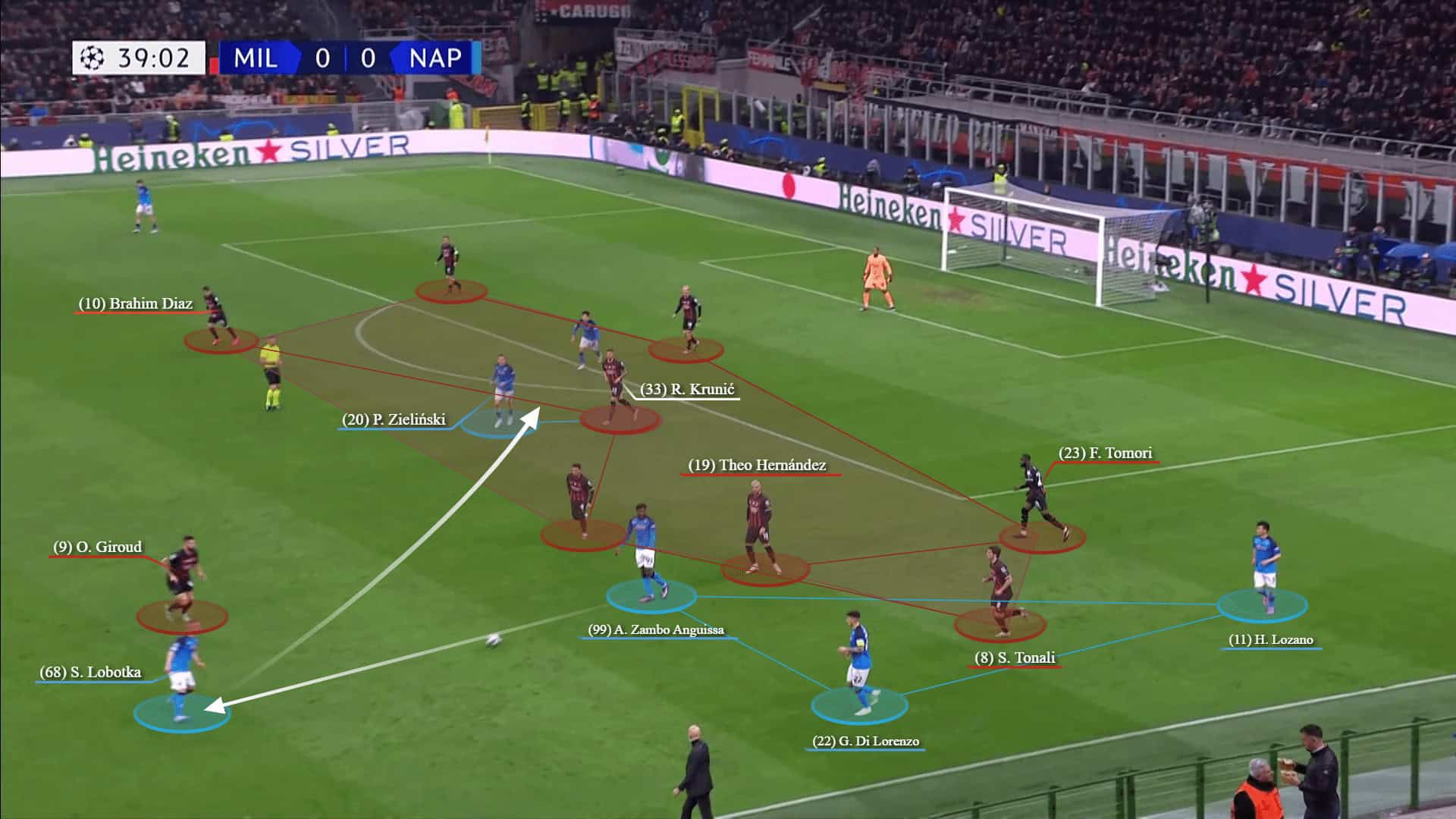If you fell down yesterday, stand up today.
AC Milan, a seven-time UEFA Champions League victor, has made it to the semi-finals after a 1-1 draw with Napoli at Diego Armando Maradona stadium.
Napoli, a dominant team this season and the current leaders of Serie A, were defeated 1-0 by the Rossoneri in the first leg at San Siro.
Maignan’s brilliance during both games was remarkable and enabled AC Milan to reach the Champions League semi-finals for the first time since the 2006/07 season.
This tactical analysis will illustrate tactics that Stefano Pioli executed to beat Luciano Spalletti and analyse how Milan stopped Napoli completely.
Lineups
Luciano Spalletti, the coach of Napoli, made some changes to his team for the second leg by bringing back his striker Osimhen who was absent in the first leg. Meanwhile, Tanguy Ndombele replaced the dismissed André-Frank Zambo Anguissa in the midfield, and the team was structured in a flexible 4-3-3 shape.
Napoli XI: Meret; Di Lorenzo, Rrahmani, Jesus, Rui; Zielinski, Lobotka, Ndombele; Politano, Osimhen, Kvaratskhelia.
On the other hand, Stefano Pioli retained the same players in a 4-2-3-1 formation for the second leg.
AC Milan XI: Maignan; Calabria, Kjaer, Tomori, Hernandez; Krunic, Tonali; Bennacer, Diaz, Giroud, Leao.

AC Milan looks bright and adaptable
Throughout both matches against Napoli, AC Milan demonstrated their ability to adapt and modify their tactics.
Pioli, who always relies on the 4-2-3-1 structure in possession, started with Bennacer as a number ’10’ in front of Tonali and Krunic who were the double-pivot. AC Milan attempted to build their play from the back, with a 2-2 static base but used different mechanics to counter Napoli’s high-pressing 4-4-2 scheme during both games.
The intensity of Napoli’s pressing differed from the first leg to the second leg. With Osimhen in the lead of the pressure and 1-0 behind, the pressure was fiercer.
In the deeper build-up, AC Milan’s centre-backs moved wide alongside Maignan, while Krunic and Tonali positioned themselves in front, creating a 3-2 structure against Napoli’s first line.

The Rossoneri’s static positioning during the build-up phase, as shown in the graphic below, remained consistent in both games. They utilised a 2-2 base, with the fullbacks pushed up higher hugging the sideline. Meanwhile, Diaz moved inside and positioned himself on the same horizontal line as Bennacer (Roamers), ready to receive in between the lines and win the second balls. Leao moved higher up the pitch, alongside Giroud, ready to receive any possible long balls.

In the first leg at San Siro, AC Milan focused heavily on central penetration.
Krunic was dropping deeper between the centre-backs to create a 3-1 base, as shown in the graphic below. Meanwhile, Tonali acts as the single pivot and attempted to escape the shadow of Napoli’s first line of pressure, receiving the ball between the lines. Lobotka is ready to leave the roamer Diaz and to press him immediately.

Milan also relied heavily on playing long balls as a solution, targeting Giroud and Leao. Diaz and Bennacer were positioned in both half-spaces, ready to receive the lay-offs or win the second balls due to their positional and dynamic superiority over Lobotka and Ndombele.
In the second leg at the Diego Armando Maradona stadium, the build-up’s fluidity changed and the mechanism of the 3-1 base differed, with a focus on wide progression and maintaining long balls as a primary weapon.
Tonali tended to drop off to the left side (creating an overload on that flank with Hernandez and Leao against two Napoli players), while Krunic remained central, facing tight marking from one of Napoli’s first-line pressors while the other was pressing higher.
Here below, Ndombele immediately pushed higher to press Tonali after drifting wide and receiving the ball from Maignan. Politano waited with Hernandez on the left, and Krunic was marked by Zielinski. Lobotka was forced to move horizontally to cover Ndomblle and mark Bennacer, leaving Diaz free after making a brilliant inside movement to avoid Kvara’s shadow. The situation left Diaz and Calbria free in vulnerable areas. Tonali perfectly finds Diaz between the lines with a long ball.

— and then Diaz switches the play to the right side where Calabria is overlapping while Mario Rui, Napoli’s left-back, had been dragged with his own backline. This allows Calabria to exploit the space and make a dangerous run towards the final third.

In the below situation shows another execution. Politano decides to press the dropped Tonali instead of Ndombele like in the previous scene. Theo Hernandez moved well to open the lane for Tonali’s pass. Once he received the ball behind Politano, Ndombele intended to press him so left Bennacer.

— and then Theo Hernandez progressed the play towards Giroud, who laid the ball off to Leao on the left side. Bennacer, Diaz and Leao had gained positional superiority over Napoli’s midfielders.

Milan capitalised on the fact that Tonali was dynamically positioned on the left side, creating a distance between himself and Napoli’s Osimhen or Zielinski. This led to one of Napoli’s second-line stepping out to press Tonali and then allow Milan to exploit the space behind well.
As previously stated, Milan utilised long balls as a primary tactic. Here below, when Napoli’s pressing was intense on Tonali, the Italian midfielder played a direct long ball to Giroud, where the Frenchman is often dominant, and still, there is good presence for the second ball. Theo receives here then lays it off in a big space.

Earlier, in Milan’s wasted penalty scene in the first half, the same approach was implemented but from the other side.
Once Krunic received behind Napoli’s first line, Kvaratskhelia is forced to go out to press, while Lobotka is accelerating to get to Calabria before the ball reached him.

Fortunately, Calabria received the ball and plays directly to where Diaz and Bennacer were positioned. Ndombele and Lobotka are out of play now which forced the defence line to drop.

The ball was then switched to the left, where Hernandez and Leao found space and executed 1-2s against the right-back Di Lorenzo. Leao eventually won a penalty after being fouled recklessly by Rui.

The passing maps of Tonali in the second leg and Krunic in the first leg suggest that the latter tends to play centrally, while Tonali focuses on left-side progression.

After scoring the first goal and taking a 2-0 lead on aggregate, Napoli took possession and Milan’s focus naturally shifted away from dominating the centre. They began to rely heavily on long balls with similar patterns against Napoli’s high pressing and high regains which had been increased from the first leg to the second, as the below graphic displays.

Individual ingenuity during transitions
If we observe the two goals that Milan scored in the two matches, we can notice that they are quite alike in terms of their execution, even though the goal-scorers were different. What stands out about both goals is the ingenuity of individuals and the quickness of the transitions.
In San Siro, before Milan’s furst goal from a transition, Napoli were on the right side, with a triangle consisting of Lozano, Zambo Anguissa, and Di Lorenzo, which was stuck against four Milan defenders. Zambo Anguissa played the ball back to Lobotka who was acting as a relay player and then played a risky pass centrally towards Zielinski, who was marked by Krunic, like in the below graphic.

Meanwhile, Giroud dropped back to help the defence and Leao remained part of the rest attack, keeping the two Napoli centre-backs occupied since they were marking him.
The scene continued, and once Calabria received from Krunic’s touch, he delivered it immediately to Diaz. Napoli attempted to counter-press quickly with three players, yet Diaz’s skill was very impressive.

Here below, after bypassing them, Milan had a numerical advantage with a 5v3. Giroud made a diagonal run, dragging Di Lorenzo inside, while Bennacer moved towards the backline’s left blindside. At the same time, Leao made an in-to-out movement, distracting the centre-backs and creating space for his teammates to exploit.

After receiving the ball on the right, Leao played a perfectly weighted through ball into space towards Bennacer who made a powerful run towards the box and scored with a left-footed shot, giving Milan the lead.


At the Diego Armando Maradona Stadium, Kvaratskhelia moved inside at the time that Milan closed the depth strongly and the defenders were very close to Osimhen into the box. Kvaratskhelia played the ball to Ndombele, who had a heavy touch.

Leao, who recovered late, succeeded to regain the ball there and initiated a brilliant display of individual skill in front of Napoli’s defenders, reminiscent of Maradona’s performances in the same stadium decades ago.

He cut the ball back to Giroud who deceived the centre-back with a double run before scoring the goal that secured their qualification.

Not only were Leao and Diaz ingenious, but Maignan was a hero in the two matches and saved a penalty kick from Kvaratskhelia. According to the below graphic, he conceded a goal from an xG of 2.91 in both games which doesn’t include penalties.

Conclusion
This result took everyone by surprise given the contrast between the two sides in Serie A.
The tactical analysis explained how Milan utilised their build-up play and individual skills to defeat Napoli and secure a spot in the semi-finals.
Despite Napoli’s impressive performances this season, Milan demonstrated their mental and tactical strength and will now face bitter rivals Internazionale in the upcoming semi-final match for the first time in a Champions League knockout tie since 2005.





Comments